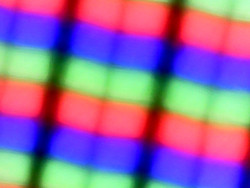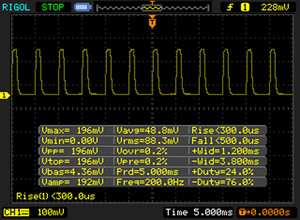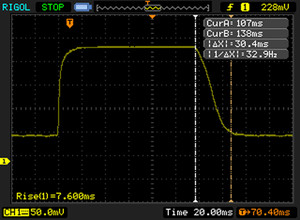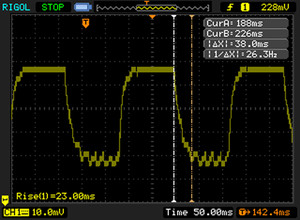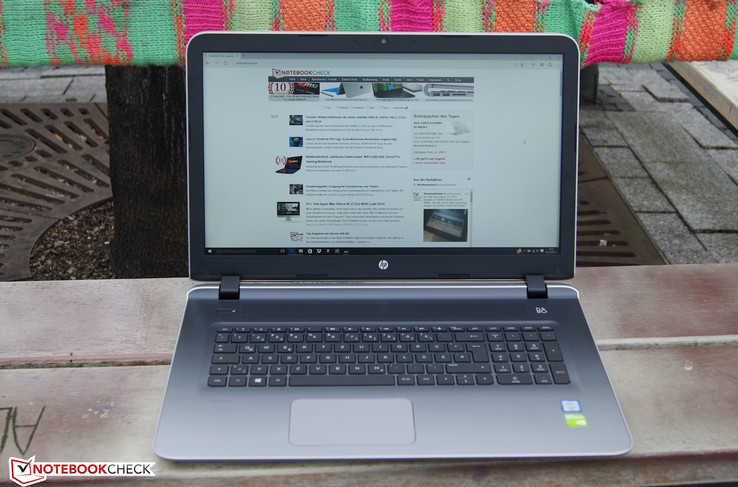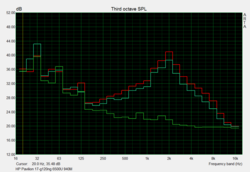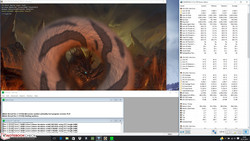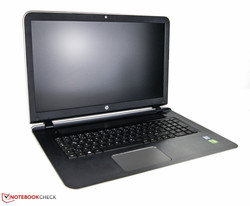HP Pavilion 17-g120ng Notebook Review

For the original German review, see here.
A short time ago, we scrutinized the previous model of the 17.3-inch Pavilion series with Broadwell processor. Now HP uses the current Intel Skylake generation. Instead of an Intel Core i7-5500U, the Pavilion 17 uses an Intel Core i7-6500U. The manufacturer has incorporated an Nvidia GeForce 940M, in order to cope with multimedia requirements. The RAM capacity is slightly smaller in the current model, but it is sufficient with 8 GB. The storage device is still a 1 TB hard drive. Furthermore, the specifications are not different from the predecessor. The test model is offered for 950 Euros (~$1020) on the manufacturer's website. This is a steep 50 Euros (~$54) more than the almost equivalent alternative model.
In this test we will focus on the changes. Please refer to our already reviewed model for details about the casing and input devices.
Display
HP continues to use a high-end IPS display with a Full HD resolution of 1920x1020 pixels. The manufacturer uses a matte panel in order to reduce reflections. It’s brightness of about 292 cd/m² is high enough. The contrast of 1144:1 is an improvement. Thanks to a good black value of 0.27 cd/m², black appears quite deep.
The brightness distribution of the display has to be criticized. There is a brightness difference of 40 cd/m² between the lower right corner and the upper left corner. This brightness difference is quite obvious on closer inspection.
| HP Pavilion 17-g120ng GeForce 940M, 6500U, Toshiba MQ01ABD100 | Acer Aspire E5-772G-70VP GeForce 940M, 5500U, Kingston RBU-SNS8100S3128GD | HP Pavilion 17-g013ng GeForce 940M, 5500U, Seagate ST1000LM014 Solid State Hybrid Drive | Asus F751LB-T4030H GeForce 940M, 5500U, Seagate Momentus SpinPoint M8 ST1000LM024 | |
|---|---|---|---|---|
| Display | -0% | 0% | 8% | |
| Display P3 Coverage (%) | 65.7 | 69.4 6% | 66.5 1% | 74.2 13% |
| sRGB Coverage (%) | 97.6 | 91.9 -6% | 97.1 -1% | 99.2 2% |
| AdobeRGB 1998 Coverage (%) | 67.7 | 67.3 -1% | 68.4 1% | |
| Response Times | ||||
| Response Time Grey 50% / Grey 80% * (ms) | 70 ? | |||
| Response Time Black / White * (ms) | 46 ? | |||
| PWM Frequency (Hz) | 200 ? | |||
| Screen | -51% | 1% | -3% | |
| Brightness middle (cd/m²) | 309 | 243 -21% | 321 4% | 353 14% |
| Brightness (cd/m²) | 292 | 284 -3% | 308 5% | 336 15% |
| Brightness Distribution (%) | 86 | 79 -8% | 89 3% | 85 -1% |
| Black Level * (cd/m²) | 0.27 | 0.45 -67% | 0.32 -19% | 0.29 -7% |
| Contrast (:1) | 1144 | 540 -53% | 1003 -12% | 1217 6% |
| Colorchecker dE 2000 * | 4.53 | 12.04 -166% | 3.79 16% | 7.03 -55% |
| Greyscale dE 2000 * | 5.66 | 13.25 -134% | 4.75 16% | 6.08 -7% |
| Gamma | 2.62 84% | 2.6 85% | 2.37 93% | 2.15 102% |
| CCT | 7893 82% | 14950 43% | 7130 91% | 7457 87% |
| Color Space (Percent of AdobeRGB 1998) (%) | 62 | 60 -3% | 62 0% | 65 5% |
| Color Space (Percent of sRGB) (%) | 98 | 92 -6% | 97 -1% | 99 1% |
| Total Average (Program / Settings) | -26% /
-39% | 1% /
1% | 3% /
-1% |
* ... smaller is better
| |||||||||||||||||||||||||
Brightness Distribution: 86 %
Center on Battery: 309 cd/m²
Contrast: 1144:1 (Black: 0.27 cd/m²)
ΔE ColorChecker Calman: 4.53 | ∀{0.5-29.43 Ø4.78}
ΔE Greyscale Calman: 5.66 | ∀{0.09-98 Ø5}
98% sRGB (Argyll 1.6.3 3D)
62% AdobeRGB 1998 (Argyll 1.6.3 3D)
67.7% AdobeRGB 1998 (Argyll 3D)
97.6% sRGB (Argyll 3D)
65.7% Display P3 (Argyll 3D)
Gamma: 2.62
CCT: 7893 K
Screen Flickering / PWM (Pulse-Width Modulation)
| Screen flickering / PWM detected | 200 Hz | ≤ 50 % brightness setting | |
The display backlight flickers at 200 Hz (worst case, e.g., utilizing PWM) Flickering detected at a brightness setting of 50 % and below. There should be no flickering or PWM above this brightness setting. The frequency of 200 Hz is relatively low, so sensitive users will likely notice flickering and experience eyestrain at the stated brightness setting and below. In comparison: 53 % of all tested devices do not use PWM to dim the display. If PWM was detected, an average of 8111 (minimum: 5 - maximum: 343500) Hz was measured. | |||
Display Response Times
| ↔ Response Time Black to White | ||
|---|---|---|
| 46 ms ... rise ↗ and fall ↘ combined | ↗ 16 ms rise | |
| ↘ 30 ms fall | ||
| The screen shows slow response rates in our tests and will be unsatisfactory for gamers. In comparison, all tested devices range from 0.1 (minimum) to 240 (maximum) ms. » 99 % of all devices are better. This means that the measured response time is worse than the average of all tested devices (20.2 ms). | ||
| ↔ Response Time 50% Grey to 80% Grey | ||
| 70 ms ... rise ↗ and fall ↘ combined | ↗ 32 ms rise | |
| ↘ 38 ms fall | ||
| The screen shows slow response rates in our tests and will be unsatisfactory for gamers. In comparison, all tested devices range from 0.165 (minimum) to 636 (maximum) ms. » 99 % of all devices are better. This means that the measured response time is worse than the average of all tested devices (31.6 ms). | ||
According to the CalMAN analysis, the color and grayscales have deteriorated slightly. The DeltaE shift is about 4.53 for the colors and even slightly higher for the grayscales with 5.66. There is even a slight blue tint visible.
As we have already seen in the model with a different configuration, the color coverage is especially good: The sRGB space is almost completely covered (98%) and the AdobeRGB coverage is 62%.
The large test model can be used outdoors when the sky is overcast. However, the display brightness cannot compensate for direct sunlight.
Performance
The HP Pavilion 17 comes with all the components that are necessary for multimedia tasks. The powerful CPU is coupled with a capable graphics card, which can cope with current games. The manufacturer does not provide any options. There is only a weaker model with AMD components available for 600 Euros (~$644). Anyone hoping for fast SSD storage will need to add it themselves or buy a different 17-inch model from an alternative HP series.
Processor
Our test model houses a brand new Intel Core i7-6500U of the recently released Skylake generation. The used processor is one of the frugal series of mobile Intel CPUs. Intel specifies a TDP of only 15 W. Two cores (four threads) clock at a base clock of 2.5 GHz and the clock rate can increase to up to 3.1 GHz (both cores: 3 GHz). With Cinebench R15, we want to check, how much the new CPU differs from the previous model's Intel Core i7-5500U. Our comparison shows that HP's new Pavilion is about 9% faster in multi core use, while it performs only 5% better than the Acer TravelMate P277 (Intel Core i7-5500U).
According to Cinebench 15, a performance loss is not to be expected on battery.
Further comparisons of the used CPU can be found in our benchmark table of mobile processors.
System Performance
Our test model is equipped with powerful components. Unfortunately, it does not run absolutely smoothly due to a magnetic disk. The response time is often relatively long. This will be particularly noticeable to users used to SSD storage. Thus, the HP Pavilion cannot keep up with competing notebooks with SSDs. It is also very surprising that the new Pavilion 17 achieves about 300 points less than its predecessor.
| PCMark 7 Score | 2811 points | |
Help | ||
Storage Device
As in the previous test, the manufacturer uses a 5400 RPM hard drive. The 2.5-inch storage device features a capacity of 1 TB. The read and write rates of almost 100 MB/s are common for magnetic disks.
Next, we check the performance of the SD card reader with a Toshiba Exceria Pro SDXC 64 GB UHS-II in a realistic copy and read scenario. Copying JPG files (about 5 MB each) is done at 31 MB/s. In the AS SSD benchmark, the sequential read rate is about 84.8 MB/s, while the write rate is about 61.4 MB/s.
Graphics Card
As in our previously reviewed model, HP uses an Nvidia GeForce 940M in the Pavilion 17. The used graphics card is mid-range and features 4096 MB of VRAM here. In 3DMark 11, our test model achieves 2438 points. The HP Pavilion 17-g013 scores the same. Overall, the used graphics card performs as expected.
Further benchmarks and comparisons of the used graphics unit can be found in our benchmark list of current notebook graphics cards.
| 3DMark 11 - 1280x720 Performance (sort by value) | |
| HP Pavilion 17-g120ng | |
| Acer TravelMate P277-MG-7474 | |
| HP Pavilion 17-g013ng | |
| Asus F751LB-T4030H | |
| 3DMark 11 Performance | 2438 points | |
| 3DMark Ice Storm Standard Score | 42425 points | |
| 3DMark Cloud Gate Standard Score | 6452 points | |
| 3DMark Fire Strike Score | 1387 points | |
Help | ||
Gaming Performance
As we have already seen in our previous test, the Nvidia GeForce 940M is even suitable for newer games. However, you have to select medium settings and a resolution of 1366x768 in most of them. In order to compare the gaming performance to the other Pavilion model, we have run the game “Battlefield Hardline”. Both models perform the same.
Our article, "Computer Games on Laptop Graphics Cards?" shows which other games will run on the used graphics card.
| Battlefield 4 | |
| 1366x768 Battlefield 4 medium (sort by value) | |
| 1366x768 Battlefield 4 high (sort by value) |
| low | med. | high | ultra | |
|---|---|---|---|---|
| Battlefield Hardline (2015) | 74.2 | 50.8 | 17 | 10.1 |
Emissions & Energy
System Noise
Even while idling, the test model is always audible. This is due to the option "Fan always on" being enabled in the BIOS. If you deactivate it, the fan is quieter - at least while the system is idle. The test model gets rather loud under load with up to 47 dB(A). The previous model was disturbingly loud with 50 dB(A). We expect a better and quieter cooling in a large 17-inch notebook.
Noise level
| Idle |
| 33.5 / 33.5 / 33.5 dB(A) |
| DVD |
| 37.6 / dB(A) |
| Load |
| 45 / 47 dB(A) |
 | ||
30 dB silent 40 dB(A) audible 50 dB(A) loud |
||
min: | ||
Temperature
Unfortunately, the current model of the Pavilion 17 gets 3 °C (~6 °F) warmer than its predecessor with a hotspot of 47 °C (~117 °F) on the underside. The notebook even reaches 46 °C (~115 °F) at the keyboard, which is clearly noticeable at the number pad. However, it is not to be expected that the maximum temperature is reached during everyday tasks. The temperature does not even climb that high during gaming. Thus, these high values should not put you off too much.
The core temperatures of the CPU during a load scenario are interesting too. With our stress test programs, FurMark and Prime95, we simulate such a scenario. After more than one hour, the CPU can still work at its Turbo Boost of 2900 MHz and the maximum core temperatures are about 80 °C (~176 °F). Thus, throttling will not occur. After the stress test, we restarted the 3DMark 11 benchmarks: The score is the same as that of the cold start.
(-) The maximum temperature on the upper side is 46 °C / 115 F, compared to the average of 36.9 °C / 98 F, ranging from 21.1 to 71 °C for the class Multimedia.
(-) The bottom heats up to a maximum of 47 °C / 117 F, compared to the average of 39.2 °C / 103 F
(+) In idle usage, the average temperature for the upper side is 23.5 °C / 74 F, compared to the device average of 31.3 °C / 88 F.
(+) The palmrests and touchpad are cooler than skin temperature with a maximum of 31.7 °C / 89.1 F and are therefore cool to the touch.
(-) The average temperature of the palmrest area of similar devices was 28.7 °C / 83.7 F (-3 °C / -5.4 F).
Power Consumption
While idling, the test model is not particularly power-hungry for its size with up to 10 W. Under load, the power consumption is between 45 W and 63 W. This is normal in view of the used components. During standby, the power consumption is about 0.6 W.
| Off / Standby | |
| Idle | |
| Load |
|
Key:
min: | |
Battery Life
The manufacturer has not changed the 41 Wh battery.
We ran our Wi-Fi test, which simulates realistic web surfing at a brightness of 150 cd/m². The battery life is 4 hours and 16 minutes, which is almost equivalent to that of the previously reviewed model. The battery life is particularly good for a 17-inch notebook.
| Battery Runtime - WiFi Websurfing (sort by value) | |
| HP Pavilion 17-g120ng | |
| HP Pavilion 17-g013ng | |
| Acer Aspire E5-772G-70VP | |
| Asus F751LB-T4030H | |
Pros
Cons
Verdict
HP continues the concept of the Pavilion 17 in this small update and once again delivers a solid all-round device. In our previous test we had already noticed the decent display and good performance. Unfortunately, the cooling system and system noise have not improved. It is particularly annoying that the new model costs 50 Euros (~$54) more, even though the performance has remained almost the same.
Overall, HP's bundle is alright. Anyone looking for a large and capable notebook, will find it in our test model.
However, you should also consider competitors like the Acer Aspire E5-772G. Since the difference compared to the Broadwell version is small, prospective buyers should take advantage of the predecessor's lower price.
HP Pavilion 17-g120ng
- 01/12/2016 v5 (old)
Nino Ricchizzi




